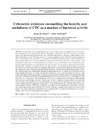Identificador persistente para citar o vincular este elemento:
https://accedacris.ulpgc.es/handle/10553/51653
| Campo DC | Valor | idioma |
|---|---|---|
| dc.contributor.author | Gasol, Josep M. | en_US |
| dc.contributor.author | Arístegui, Javier | en_US |
| dc.contributor.other | Aristegui, Javier | - |
| dc.contributor.other | Gasol, Josep M | - |
| dc.date.accessioned | 2018-11-25T02:33:19Z | - |
| dc.date.available | 2018-11-25T02:33:19Z | - |
| dc.date.issued | 2007 | en_US |
| dc.identifier.issn | 0948-3055 | en_US |
| dc.identifier.uri | https://accedacris.ulpgc.es/handle/10553/51653 | - |
| dc.description.abstract | To understand the opposing views on the utility of the CTC method, we examined bacterial abundance over incubations with the fluorogenic tetrazolium dye CTC (5-cyano-2,3-ditolyl tetrazolium chloride) and inspected the flow cytometric signatures of bacteria dually labeled with a DNA stain (Syto13) and CTC. Incubation of a marine plankton sample with CTC produced positive cells up to a stable value, reached in <1 h, while the red fluorescence of the granules increased for at least an extra hour. Incubation also produced a decrease in cell abundance of 22% after 30 min in the presence of 5 mM CTC. The decrease was a function of CTC concentration and incubation time, and particularly affected bacteria with high nucleic acid content. Flow cytometric inspection of a double-stained (CTC and Syto13) sample showed that after 15 min of incubation, particles appeared having both red (CTC+) and green (DNA+) staining. Afterwards, other particles appeared that maintained the same light scatter properties and the red fluorescence, but that lost all green fluorescence. While the number of particles with double staining stabilized after about 1 h, particles with red but without DNA staining increased for at least 100 min. Simultaneously, the classic determination of CTC+ cells (observing only the red signal of the particles) increased as reported elsewhere. We interpreted these patterns as evidence of CTF (the formazan derivative of CTC) particles growing in the bacterial cells until they are so large that they break up the cells, after which they remain present as CTF granules with no associated cellular material. Microscopic or flow cytometric enumeration of red particles might still be a good indication of the percentage of bacterial cells having taken up and reduced the activity probe, but flow cytometric cell sorting of red particles based only on scatter and red fluorescence signals will select CTF particles without associated cellular material. Our results help reconcile the ecologically sound results and the CTC toxicity evidence currently reported in the literature, and lead to a warning against interpretations of cell sorting of CTC+ particles for phylogenetic or activity studies based only on red or orange fluorescence. | en_US |
| dc.language | eng | en_US |
| dc.publisher | 0948-3055 | |
| dc.relation.ispartof | Aquatic Microbial Ecology | en_US |
| dc.source | Aquatic Microbial Ecology [ISSN 0948-3055], v. 46, p. 71-83 | en_US |
| dc.subject | 251001 Oceanografía biológica | en_US |
| dc.subject.other | CTC | en_US |
| dc.subject.other | Syto13 | en_US |
| dc.subject.other | Flow cytometry | en_US |
| dc.subject.other | Cell sorting | en_US |
| dc.subject.other | Bacterial activity | en_US |
| dc.title | Cytometric evidence reconciling the toxicity and usefulness of CTC as a marker of bacterial activity | en_US |
| dc.type | info:eu-repo/semantics/Article | en_US |
| dc.type | Article | en_US |
| dc.identifier.doi | 10.3354/ame046071 | |
| dc.identifier.scopus | 33847156414 | - |
| dc.identifier.isi | 000244194200006 | - |
| dcterms.isPartOf | Aquatic Microbial Ecology | |
| dcterms.source | Aquatic Microbial Ecology[ISSN 0948-3055],v. 46 (1), p. 71-83 | |
| dc.contributor.authorscopusid | 7003299234 | - |
| dc.contributor.authorscopusid | 7006816204 | - |
| dc.description.lastpage | 83 | - |
| dc.description.firstpage | 71 | - |
| dc.relation.volume | 46 | - |
| dc.investigacion | Ciencias | en_US |
| dc.type2 | Artículo | en_US |
| dc.contributor.daisngid | 97985 | - |
| dc.contributor.daisngid | 227201 | - |
| dc.identifier.investigatorRID | D-5833-2013 | - |
| dc.identifier.investigatorRID | B-1709-2008 | - |
| dc.utils.revision | Sí | en_US |
| dc.contributor.wosstandard | WOS:Gasol, JM | |
| dc.contributor.wosstandard | WOS:Aristegui, J | |
| dc.date.coverdate | Enero 2007 | |
| dc.identifier.ulpgc | Sí | es |
| dc.description.jcr | 2,385 | |
| dc.description.jcrq | Q1 | |
| dc.description.scie | SCIE | |
| item.grantfulltext | open | - |
| item.fulltext | Con texto completo | - |
| crisitem.author.dept | GIR IOCAG: Oceanografía Biológica y Algología Aplicada | - |
| crisitem.author.dept | IU de Oceanografía y Cambio Global | - |
| crisitem.author.dept | Departamento de Biología | - |
| crisitem.author.orcid | 0000-0002-7526-7741 | - |
| crisitem.author.parentorg | IU de Oceanografía y Cambio Global | - |
| crisitem.author.fullName | Arístegui Ruiz, Javier | - |
| Colección: | Artículos | |
Citas SCOPUSTM
37
actualizado el 08-jun-2025
Citas de WEB OF SCIENCETM
Citations
38
actualizado el 08-jun-2025
Visitas
96
actualizado el 27-abr-2024
Descargas
81
actualizado el 27-abr-2024
Google ScholarTM
Verifica
Altmetric
Comparte
Exporta metadatos
Los elementos en ULPGC accedaCRIS están protegidos por derechos de autor con todos los derechos reservados, a menos que se indique lo contrario.
